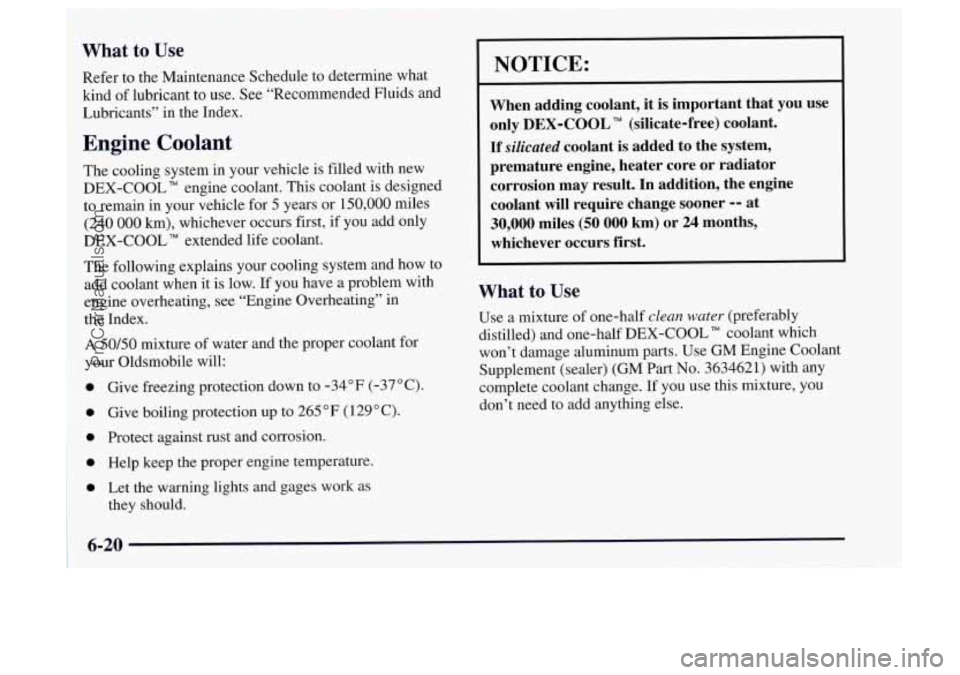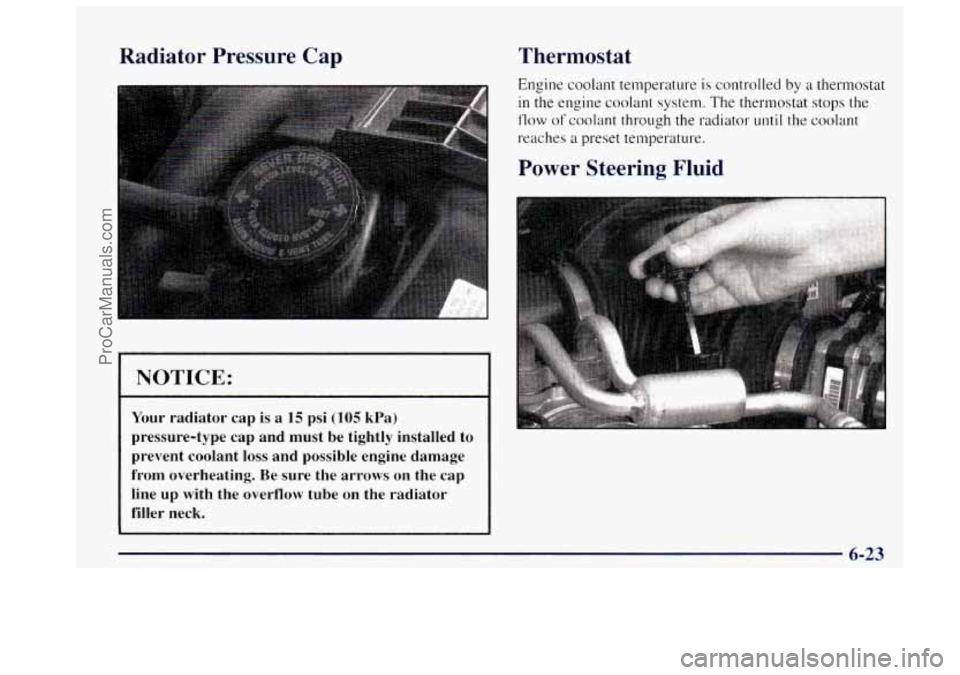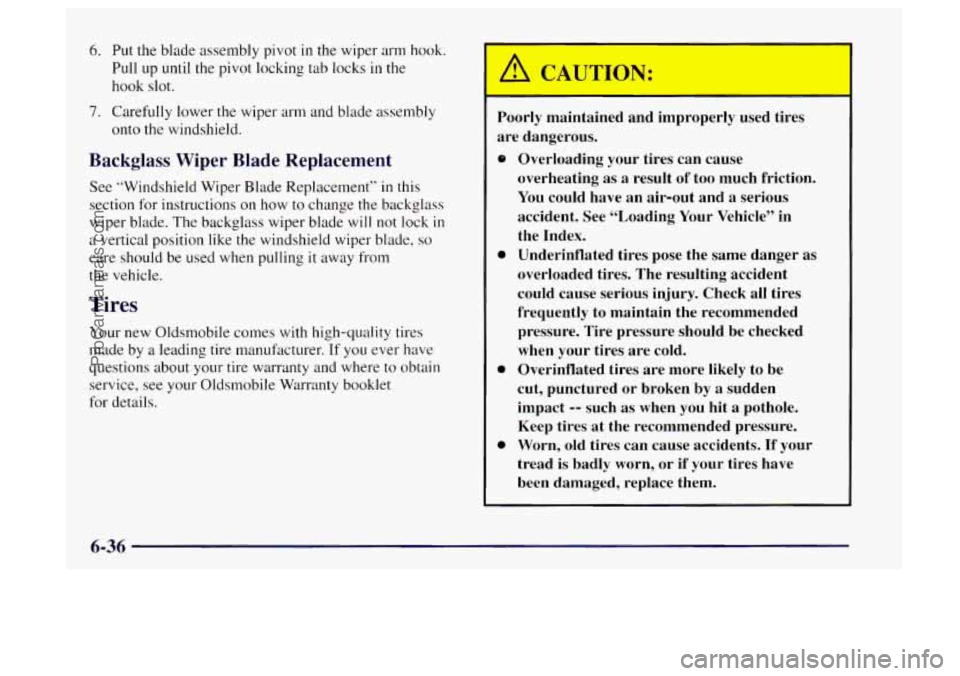1997 OLDSMOBILE BRAVADA overheating
[x] Cancel search: overheatingPage 110 of 358

Anti-Lock Brake System Warning Light
With the anti-lock brake
system, this light
will come
on when you start your
ANTI - LOCK engine and may stay on for I
If the light stays on, or comes on when you’re driving,
your Oldsmobile needs service.
If the regular brake
system warning light isn’t on, you still have brakes, but
you don’t have anti-lock brakes. If the regular brake
system warning light is also
on, you don’t have anti-lock
brakes and there’s a problem with
your regular brakes.
See “Brake System Warning Light” earlier in
this section.
The anti-lock brake system warning light should come
on briefly when you turn
the ignition key to RUN. If the
light doesn’t corne on then, have
it fixed so it will be
ready to warn you
if there is a problem.
Engine Coolant Temperature Gage
I
This gage shows the engine
coolant temperature.
If the
gage pointer moves into the
red area, your engine
is
too hot!
TEMP
It means that your engine coolant has overheated. If you
have been operating your vehicle under normal driving
conditions, you should pull off the road, stop your
vehicle and turn
off the engine as soon as possible.
In “Problems on the Road,” this manual shows you what
to do. See ”Engine Overheating’‘
in the Index.
2-56
ProCarManuals.com
Page 183 of 358

Driving On Grades
Reduce speed and shift to a lower gear before you start
down a long or steep downgrade.
If you don’t shift
down, you might have to use your brakes
so much that
they would get hot and no longer work well.
On a long uphill grade, shift down and reduce your
speed to around
45 mph (70 km/h) to reduce the
possibility of engine and transmission overheating.
You should use THIRD
(3) when towing a trailer.
Operating your vehicle in THIRD
(3) when towing a
trailer will minimize heat buildup and extend the life of
your transmission.
Parking on Hills
You really should not park your vehicle, with a trailer
attached, on a hill. If something goes wrong, your rig
could start to move. People can be injured, and both
your vehicle and the trailer can be damaged.
But if
YOU ever have to park your rig on a hill, here’s
how to do it:
1. Apply your regular brakes, but don’t shift into
PARK
(I?) yet. Then turn your wheels into the curb if
facing downhill or into traffic if facing uphill.
2. Have someone place chocks under the trailer wheels.
3. When the wheel chocks are in place, release the
regular brakes until the chocks absorb the load.
4. Reapply the regular brakes. Then apply your parking
brake and shift into PARK
(P).
5. Release the regular brakes.
4-51
ProCarManuals.com
Page 187 of 358

Section 5 Problems on the Road
Here you’ll find what to do about some problems that can occur on the road.
5-2
5-3
5-3
5-7
5- 10
5-11
5-12
5- 12
5- 14 How
to Use
Warning Flashers
Other Types of Warning Devices
Step-by-step Procedure for Jump Starting
Information You Should Know Before Towing
Towing Your Vehicle From the Front
Towing Your Vehicle From the Rear
If Your Engine
is Overheating
If Steam is Coming From Your Engine
Cooling System 5-16
5-21
5-21
5-29
5-30
5-3 1
5-32
5-32 How to Add
Coolant
What to do if a Tire Goes Flat
How to Change a Flat Tire
Where to Store the Flat Tire and Tools
Information on the Compact Spare Tire
If You’re Stuck in Sand, Mud, Snow or on Ice
How to Rock Your Vehicle to Get Unstuck
Using Recovery Hooks
5-1
ProCarManuals.com
Page 198 of 358

Engine Overheating
’ You will find a coolant temperature gage on your
vehicle’s instrument panel. See “Gages” in the Index.
If Steam Is Coming From Your Engine
Steam from an overheated engine can burn you
badly, even if you just open the hood. Stay away
from the engine
if you see or hear steam coming
from it. Just turn it off and get everyone away
from the vehicle until it cools down. Wait until
there is no sign
of steam or coolant before you
open the hood.
If you keep driving when your engine is
overheated, the liquids in it can catch
fire. You or
others could be badly burned. Stop your engine if
it overheats, and get out of the vehicle until the
engine is cool.
NOTICE:
If your engine catches fire because you keep
driving with
no coolant, your vehicle can be
badly damaged. The costly repairs would not be
covered by your warranty.
5-12
I
ProCarManuals.com
Page 240 of 358

1
; What to Use
I Refer to the Maintenance Schedule to determine what
’ kind of lubricant to use. See “Recommended Fluids and
i Lubricants” in the Index.
1 , I Engine Coolant
; The cooling system in your vehicle is filled with new
1 DEX-COOL” engine coolant. This coolant is designed
I to remain in your vehicle for 5 years or 150,000 miles
I (240 000 km), whichever occurs first, if you add only
~ DEX-COOL” extended life coolant.
I i The following explains your cooling system and how to
i
~
i
add coolant when it is low. If you have a problem with
engine overheating, see “Engine Overheating” in
the Index.
I
A 50/50 mixture of water and the proper coolant for
1 your Oldsmobile will:
’ 0 Give freezing protection down to -34°F (-37°C).
~ 0 Give boiling protection up to 265 “F (129°C). I
~ 0 Protect against rust and corrosion.
0 Help keep the proper engine temperature.
0 Let the warning lights and gages work as
they should.
NOTICE:
When adding coolant, it is important that you use
only
DEX-COOL TM (silicate-free) coolant.
If silicated coolant is added to the system,
premature engine, heater core or radiator
corrosion may result. In addition, the engine
coolant will require change sooner
-- at
30,000 miles (50 000 km) or 24 months,
whichever occurs first.
What to Use
Use a mixture of one-half clean water (preferably
distilled) and one-half DEX-COOL
TM coolant which
won’t damage aluminum parts. Use GM Engine Coolant
Supplement (sealer) (GM Part
No. 3634621) with any
complete coolant change.
If you use this mixture, you
don’t need to add anything else.
ProCarManuals.com
Page 243 of 358

Radiator Pressure Cap Thermostat
Engine coolant temperature is controlled
by a thermostat
in the engine coolant system. The thermostat stops the
flow of coolant through the radiator until the coolant
reaches
a preset temperature.
Power Steering Fluid
NOTICE:
Your radiator cap is a 15 psi (105 kPa)
pressure-type cap and must be tightly installed
to
prevent coolant loss and possible engine damage
from overheating. Be sure the arrows on the cap
line up with the overflow tube on the radiator
filler neck.
6-23
ProCarManuals.com
Page 256 of 358

6. Put the blade assembly pivot in the wiper arm hook.
Pull
up until the pivot locking tab locks in the
hook slot.
7. Carefully lower the wiper arm and blade assembly
onto the windshield.
Backglass Wiper Blade Replacement
See “Windshield Wiper Blade Replacement” in this
section for instructions on how to change the backglass
wiper blade. The backglass wiper blade will not lock
in
a vertical position like the windshield wiper blade, so
care should be used when pulling it away from
the vehicle.
Tires
Your new Oldsmobile comes with high-quality tires
made by
a leading tire manufacturer. If you ever have
questions about your tire warranty and where to obtain
service, see your Oldsmobile Wmanty booklet
for details. Poorly maintained and improperly used tires
are dangerous.
e
0
0
0
Overloading your tires can cause
overheating as a result
of too much friction.
You could have an air-out and
a serious
accident. See “Loading Your Vehicle” in
the Index.
Underinflated tires pose the same danger as
overloaded tires. The resulting accident
could cause serious injury. Check all tires
frequently to maintain the recommended
pressure. Tire pressure should be checked
when your tires are cold.
Overinflated tires are more likely to be
cut, punctured or broken
by a sudden
impact
-- such as when you hit a pothole.
Keep tires at the recommended pressure.
Worn, old tires can cause accidents.
If your
tread is badly worn, or if your tires have
been damaged, replace them.
6-36
ProCarManuals.com
Page 346 of 358

Electrical Equipment. Adding .................... 6-54
Electrical System
............................... 6-54
Engine
........................................ 6-8
Coolant Heater
............................... 2- 14
Coolant Level Check
.......................... 7-39
Coolant Temperature Gage
..................... 2-56
Exhaust
..................................... 2-22
Identification
................................ 6-53
OilLevelCheck
.............................. 7-39
Overheating
................................. 5-12
Running While Parked
......................... 2-23
Specifications
................................ 6-60
Starting
..................................... 2-13
Engineoil
..................................... 6-9
Additives
................................... 6-12
Kind to Use
................................. 6-10
Pressure Gage
................................ 2-59
Used
....................................... 6-13
Whentochange
.............................. 6-12
Exhaust. Engine
................................ 2-22
Express-Down Window
.......................... 2-24
Exterior Metal Parts. Protecting
.................... 6-49
Fabric cleaning
............................... 6-45
FillingYourTank
................................ 6-5
Filter.
Air ..................................... 6-13
Finish Care
.................................... 6-49 Finish
Damage
.................................
Flat Tire. Changing ............................. 5-21
Fluids and Lubricants
....................... 6-61. 7-45
Fog Lamp Switch
............................... 2-33
Foreign Countries. Fuel
........................... 6-4
Front Axle
....................................... 6-18
Reading Lamp Bulb Replacement
................ 6-33
Towing
..................................... 5-10
Turn Signal Lamp Bulb Replacement
............. 6-31
Fuel
.......................................... 6-3
Filling Your Tank
.............................. 6-5
Foreign Countries
.............................. 6-4
Gage
....................................... 2-61
Fuses and Circuit Breakers
....................... 6-55
Flashers.
Hazard Wdrning
......................... 5-2
Storage Area
................................. 2-39
Gages
Engine Coolant Temperature .................... 2-56
Engine Oil Pressure
........................... 2-59
Fuel
....................................... 2-61
Garage Door Opener
............................ 2-44
GasCap
....................................... 6-5
Gear Positions
................................. 2-15
GAWR ....................................... 4-42
ProCarManuals.com